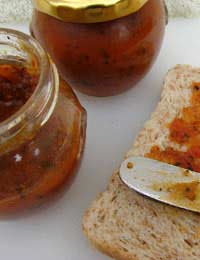
Homemade fruit chutney is a real treat. It’s also a great way to use up a basket of home-grown fruit, and share it with friends and family. Once you’ve mastered the basics of making chutney, and picked up a few traditional recipes, you can play around to create a classic recipe of your own. How about an oriental plum chutney, laced with fiery chilli, for dipping prawn crackers? Read our guide to making fruit chutney, and you’ll soon be inventing your own recipes to share and enjoy…
Making your own Chutney: the Basics…
Where to begin? The Internet is a rich source of chutney recipes. Look up Lotte Duncan and Delia Smith for some classic recipes. Favourite fruit chutneys include spicy apple (perfect for eating with crackers and cheddar), mango or apricot (a great accompaniment to Indian foods), and the old-fashioned marrow jam (often with ginger, and used on toast!). You might also wish to try green tomato chutney and plum chutney – both fruits are easily available in-season. Homemade chutney is a wonderful Christmas gift (perfect for eating with cold cuts) so make lots when the ingredients are cheap.
What goes in it? Fruit chutney is made from fresh or dried fruit, spices or other flavouring, sugar and vinegar. The sugar and vinegar usually balance one another out – you’ll note that most recipes include numerically equal amounts (100g sugar to 100ml vinegar) – to achieve that characteristic sweet and sour chutney flavour. You can make your own flavouring blends, but be careful not to be too heavy-handed. Using these guidelines, you can make chutney using any fruit you fancy.
When is it ready? Unlike jam, you don’t test for a set when making chutney. It is ready when, if you draw a wooden spoon across the pan, a channel is left for a moment before the chutney refills the space. Don’t forget that in its warm state, the chutney is a lot more fluid than it will be after cooling.
Salsa and Raita Recipes
Some cuisines feature fresh, homemade fruit or vegetable chutneys, designed to be served alongside a main course or buffet. For example, Mexican dishes – such as a spicy seared tuna steak or a hot, crunchy quesadilla – can be served with a fresh mango, papaya or pineapple salsa. This has a dual purpose: it’s a refreshing counterpoint to the rich, spicy food, and it’s also a good way to increase the vitamin content of your meal. Another cuisine that does this well is Indian – fruit raitas and lassis are served with or after courses to bring a fresh contrast to the spicy food.
Apple Raita
Serve this fresh-tasting raita with your favourite curry, particularly a dryish curry like bhuna or bhajee. It’s also lovely scooped up on oven-toasted pitta chips or fluffy, stretchy naan breads. Serve a dish of mango chutney (see above) alongside.
You need:
Half a medium cucumber (to yield ½ cup diced flesh)
One small apple (to yield ½ cup diced flesh)
1/2 cup plain yoghurt
Squeeze of lemon juice
2tbsp chopped fresh coriander
Salt
First prepare the cucumber: peel it, halve it lengthways and scoop out the seeds. Sprinkle lightly with salt and leave the two halves on a piece of kitchen towel to drain out some of the moisture. Core and dice the apple finely. In a bowl, combine all of the ingredients, then taste for seasoning. Serve soon after making.
